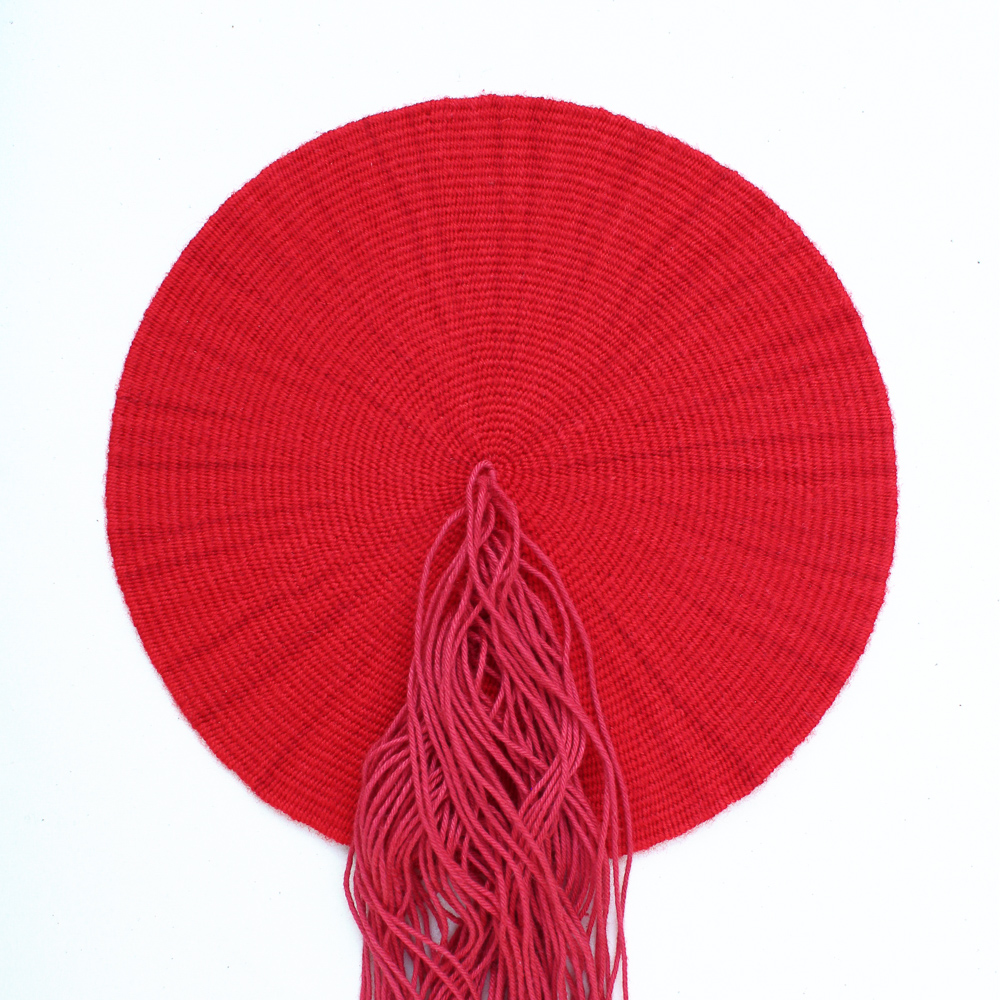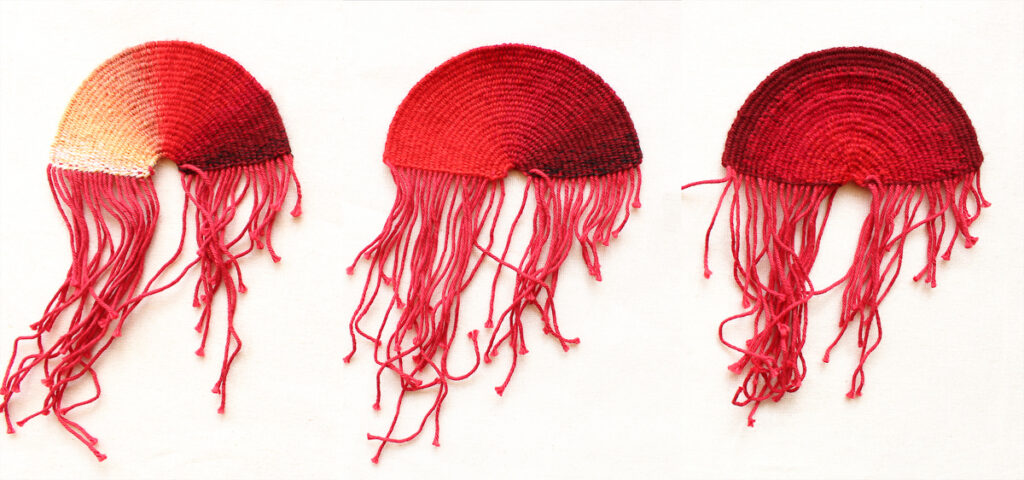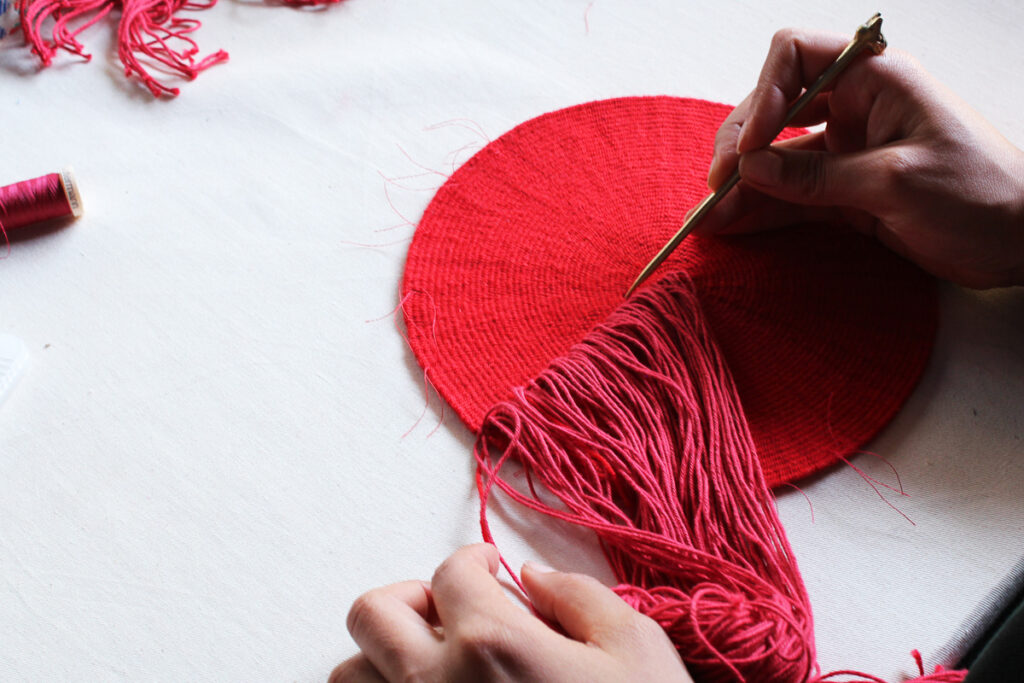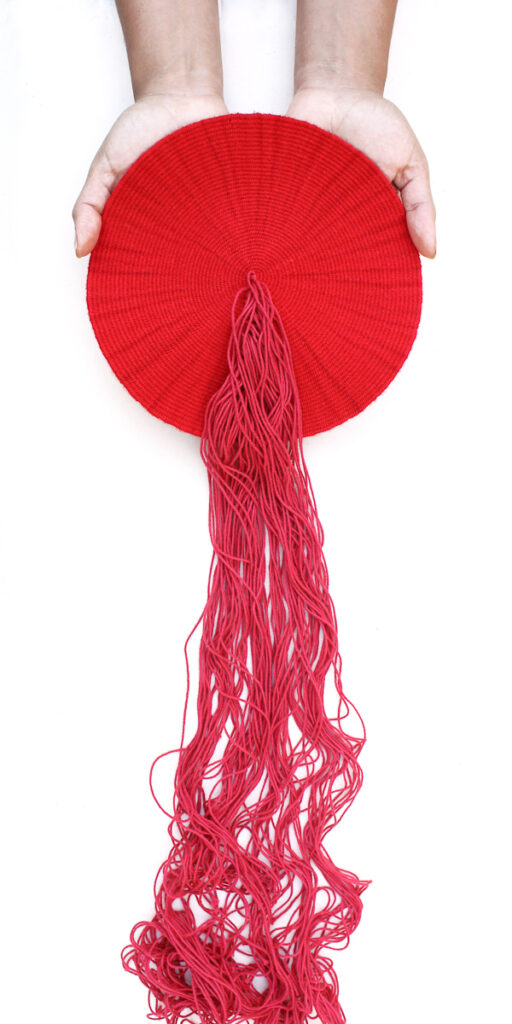- Daniela Contreras Flores. Circular Inheritance – Final piece. 2020.Cotton and wool.20x20cm
- Daniela Contreras Flores. Circular Inheritance – Volumen. 2019.Cotton and wool.5x5x5cm
- Daniela Contreras Flores. Circular Inheritance – Gradient. 2019.Cotton and wool 10x20cm
- Daniela Contreras Flores. Circular Inheritance – Process. 2020.Cotton and wool 20x20cm
- Daniela Contreras Flores. Circular Inheritance – Final piece. 2020.Cotton and wool.20x20cm
Daniela Contreras Flores is inspired by the Chimú ceremonial costume to create an iris-like woven form.
Circular inheritance is an artistic creation project dedicated to studying the constructive and creative possibilities of a textile ornamentation found in the Chimú ceremonial costume (1320 AD), a heritage piece that is part of the collection of the Chilean Museum of Pre-Columbian Art.
This ornamentation corresponds to circular shapes woven into tapestry, a technique used over millennia to reproduce images thanks to the supplementary wefts that completely cover the warps. Like any piece woven on a loom, the tapestry is characterized by having its four edges at right angles, generally taking a rectangular or square format. It is in this last characteristic where the particularity of the circular format of the ornamentation of the sacred costume lies, since it breaks with the parameters conceived by the technique, transforming it into a precious research material. This mysterious construction method was unravelled by Paulina Brugnoli and Soledad Hoces de la Guardia, important researchers of the ancestral textile legacy in Chile. Their book Manual of Andean Textile Techniques: Representations documents a dodecagon which is very close, in its appearance, to the original piece.
The Chimú culture represents the cultural apogee of civilisations located in the northern lands and the Peruvian coastal centre. It bequeaths us one of the most important textile legacies in the southern hemisphere, thanks to its high technical, conceptual and visual standard. The beginnings of the Chimú period date back to 900 AD lasting until 1470, at which time its emperor Minchancaman was overthrown by the Incas, causing the dismemberment of their civilisation. This is how the Inca, drawing on this legacy, shaped its own visual and cultural imaginary, including outstanding textiles, thanks to the use of the Chimú culture artifacts and materials. With the arrival of the Spanish, the last Chimú and a large part of the Incas suffered the epidemics brought from the “old world”. The few who managed to survive were overthrown, thus silencing their textile heritage.
The Spanish conquest slowed down the creative processes of the various Latin American cultures. This has caused me to reflect on what might have happened if we had had the possibility of pursuing our own cultural development. The circular textile ornamentation, which might seem like a new methodology due to its surprising construction and modern visuality, actually corresponds to a centuries-old heritage. It contains infinite creative possibilities that can open the way to contemporary ways of thinking about tapestry and revive the lost structures conceived by the technique.
How many constructive and creative possibilities can be derived from this? It is one of the questions that I have sought to answer during this last time, and that took me, during the recent 2019, to Melbourne, where I had the opportunity to be part of the artist residency at the Australian Tapestry Workshop, one of the world’s leading textile centres. This space has a long history in its tapestry production, standing out worldwide for its ability to innovate within this technique, and also promote themes related to Australian indigenous peoples.
In Chile and Australia, we share the marks left by the conquest and the dispossession of our identity, which led us to believe that the mestizo and indigenous lacks beauty. That return to the roots seems to me fundamental, in order to be able to take up the techniques and symbols of our heritage and rediscover in them who we are, not from a Eurocentric and whitewashed perspective, but from our own.
The circle was a figure observed by various ancient cultures, representing perfection, equality, infinity and eternity, having no apparent beginning or end. Delving into this element leads us to think outside the academy, inviting us to delve into an imaginary that is linked to the sacred and ritual.
I divided this research process into four parts: the first was to decipher the perfection of the circular shape to generate a radial effect, where all the frames seem to come from the centre and do not have any type of internal partition. These fabrics were made in the same way of the original, measuring 5cm in diameter each in red. The second stage was to make volumes on a small scale, looking for container forms that house other possibilities. The third was the colour gradient. I used Andean and traditional techniques to generate fan-shaped or concentric degradations. These last two phases were made in reduced formats and correspond to negative fields that are still under investigation.
The last woven piece, inside this project called Circular Heritage, I finished soon later my residence in Australia, during the first confinement COVID-19 phase in Santiago of Chile. It corresponds to a 20×20 cm circle, woven with merino red wool, with warps of the same colour. It is the largest that I have made so far and without a doubt the hardest one. It is for sure the first of many, where I hope to keep on delving into the construction and symbolism of the ancients, as well as its personal meaning.
The iris is a perfect circle. It makes up part of us and a large part of the living beings that inhabit the earth. It lets us watch the dimension where life is generated, to understand the shapes, the colors, the spaces. The Iris, as well as the circle of the Chimú suit, has a centre, the pupil, and from that centre its project radiantly the muscles/frames. It is a door that connects our essential being with the outside, it is a door that connects the internal world to the external world.
Author
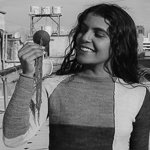 My name is Daniela Contreras Flores, I am a textile artist, I graduated from visual arts of the Universidad de Chile in 2012, since then until now, I have dedicated myself to the study, investigation, teaching and production of artworks in tapestry technique. See @dcf_artistatextil/
My name is Daniela Contreras Flores, I am a textile artist, I graduated from visual arts of the Universidad de Chile in 2012, since then until now, I have dedicated myself to the study, investigation, teaching and production of artworks in tapestry technique. See @dcf_artistatextil/
ESPAÑOL
Herencia circular es un proyecto de creación artística dedicado a estudiar las posibilidades constructivas y creativas de una ornamentación textil hallada en el traje ceremonial Chimú (1320 d.c), pieza patrimonial que forma parte de la colección del Museo Chileno de Arte Precolombino.
Dicha ornamentación corresponde a formas circulares tejidas en tapicería, técnica utilizada milenariamente para reproducir imágenes gracias a las tramas simultáneas que cubren completamente las urdimbres. Como toda pieza tejida a telar, la tapicería se caracteriza por tener sus 4 bordes en ángulo recto, obteniendo generalmente una pieza de formato rectangular o cuadrado. Es en esta última característica donde radica la particularidad del formato circular de la ornamentación de traje sagrado, pues rompe con los parámetros concebidos por la técnica, transformándolo en un preciado material de investigación, cuyo método de construcción fue destramado por Paulina Brugnoli y Soledad Hoces de la Guardia, importantes investigadoras del legado textil ansestral en Chile, quienes en su libro “Manual de técnicas textiles Andinas: Representaciones”, consiguen un dodecágono, muy cercano, en su visualidad, a la pieza original.
La cultura Chimú representa el mayor apogeo cultural logrado por las civilizaciones emplazadas en las tierras del norte y centro costero peruano, dejándonos uno de los legados textiles más importantes del hemisferio sur, gracias a su alto estándar técnico, conceptual y visual. Los inicios de su reinado remontan al 900 d.c, teniendo un largo periodo de apogeo hasta 1470, momento en que su emperador Minchancaman fue derrocado por los incas, generando el desmembramiento de su civilización. Fue así como el incario, amparado por este legado, plasmó su propio imaginario visual y cultural, destacando por sus textiles de alto nivel gracias al uso de los comocimientos y artificies de la cultura Chimú. Con la llegada de los españoles, los últimos Chimú y gran parte de los Incas, sufrieron las epidemias traídas del viejo mundo muriendo rápidamente, los pocos que lograron sobrevivir fueron derrocados, siendo el patrimonio textil uno de los más silenciados.
La supremacía de la conquista frenó los procesos creativos de las diversas culturas latinoamericanas, esto me ha invitado a reflexionar y pensar que sería de nosotros si hubiésemos tenido la posibilidad de vivir nuestro propio desarrollo cultural. La ornamentación textil circular, que podría parecer una metodología nueva, por su sorprendente construcción y moderna visualidad, corresponde a un patrimonio centenario, que alberga infinitas posibilidades creativas que pueden abrir paso a formas contemporáneas de pensar la tapicería y promover la pérdida de estructuras concebidas por la técnica. ¿Cuántas posibilidades constructivas y creativas se pueden desprender de esta?, es una de las interrogantes que he buscado responder durante este último tiempo, y que me llevaron, durante el resiente 2019, a Melbourne, donde tuve la oportunidad se ser parte de los artistas residentes del Australian Tapestry Workshop, uno de los centros de textilería más importantes del mundo. Este espacio tiene una amplia data en su producción de tapicería, destacándose a nivel mundial por su capacidad de innovar dentro de esta técnica milenaria, y además promover temáticas relativas a los pueblos indígenas australianos. Tenemos en común, Chile y Australia, las marcas dejadas por la conquista y el despojo de nuestra identidad, haciéndonos creer que lo mestizo e indigena carece de bellaza, pensando que el pasado era salvaje, carente de cultura y sin atisbos de arte, creando la idea de inferiorirdad frente a ese otro mundo, el cual nos trajo todo lo que no teníamos y nos quitó gran parte de lo que éramos. Ese retorno a la raíz, me parece fundamental, para poder retomar las técnicas y símbolos de nuestro patrimonio y redescubrir en ellos quienes somos, no desde una mirada eurocentrista y blanqueada, sino desde la propia.
El círculo fue una figura observada por diversas culturas antiguas transformándose en uno de los elementos alegóricos más relevantes dentro de la humanidad al representar perfección, igualdad, infinitud y eternidad, al no tener comienzo o fin aparente. Ahondar en este elemento nos lleva a pensar fuera de la academia, invitándonos a adentrarnos en un imaginario que se vincula a lo sagrado y ritual. Este proceso de investigación lo dividí en 4 partes: la primera fue descifrar el perfeccionamiento de la forma circular para generar un efecto radial, donde todas las tramas parecen nacer desde el centro y no tener ningún tipo de partición interna, estos tejidos se hicieron a semejanza del original, midiendo 5cm de diámetro cada uno en color rojo. La segunda etapa fue realizar volúmenes en pequeña escala, buscando formas contenedoras, fuentes que alberguen otras posibilidades. La tercera fue cromática, en ella empleé técnicas andinas y tradicionales para generar degradaciones en forma de abanico o concéntricas. Estas dos últimas fases se hicieron en formatos reducidos y corresponden a campos idagatorios que siguen estando en proceso de investigación.
La última pieza tejida, dentro de este proyecto llamado Herencia Circular, la finalicé luego de mi residencia en Australia, durante la primera fase de confinamiento por COVID-19 en Santiago de Chile. Esta corresponde a un círculo de 20×20 cm, tejido con lana merino de color rojo y con urdimbres del mismo color a la vista. Es el más grande que he realizado hasta el momento, sin dudas el más difícil, y de seguro el primero de muchos más, donde espero poder seguir ahondando en las formas de construcción y el simbolismo que esta forma tuvo para los antiguos pero por sobre todo lo que significa en mi: el iris, cuerpo circularmente perfecto y cromático, que es parte del ojo, que a su vez se deposita en el párpado, que conforma parte de nosotros y de gran parte de los seres vivos que habitan la tierra; nos permite observar la dimensión donde la vida se genera, para comprender las formas, los colores, los espacios. El Iris al igual que el círculo del traje Chimú posee un centro, la pupila, y desde ese centro se proyectan radialmente los músculos/tramas. Es una puerta que conecta nuestro ser esencial con el mundo externo, es una puerta que conecta el mundo interno con el mundo externo.

